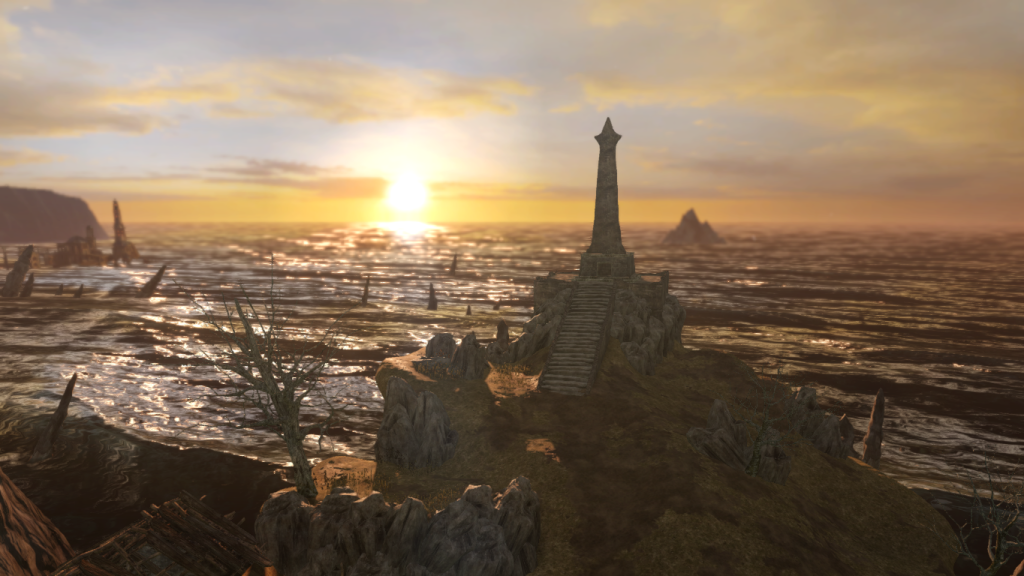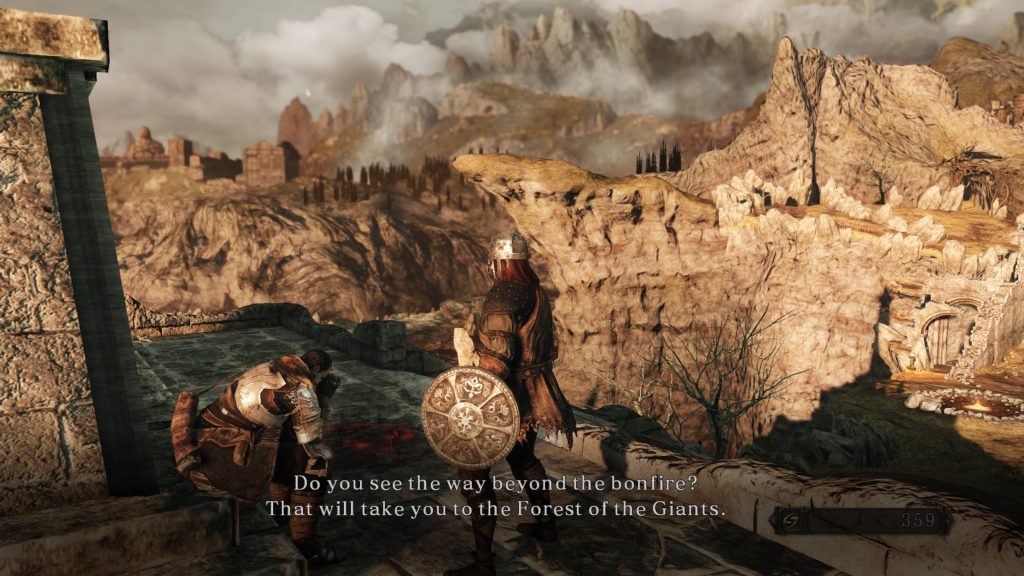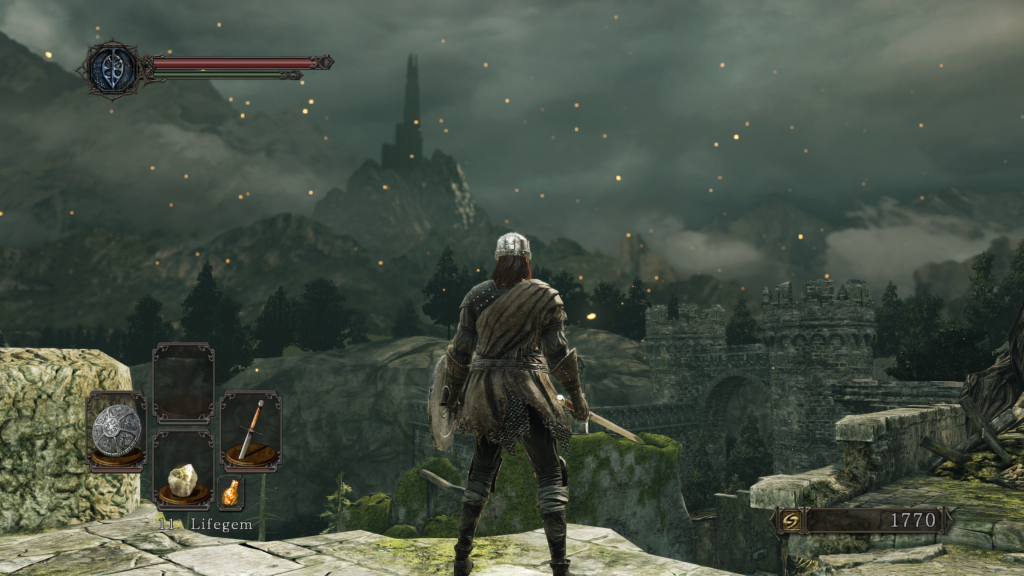
After roughly 70 hours of Elden Ring, and even starting my journey over with a brand new character that I’ve modeled after my less-than grateful fiancé, I’ve decided to take a legitimate breather, and pursue a different calling: Exploring and piecing together the strange, fever-dream-reality of Dark Souls II’s Drangleic. DSII has always fascinated me since I played through it a few summers ago back when I finally decided to put the metal to the grindstone and experience the Souls series. I powered through 20 hours of Bloodborne, then 30 hours of Dark Souls, then 30 hours of Dark Souls II, and finally got about 98% of the way through Dark Souls III before running into the absolute road block that is Lothric and Lorian (don’t worry, I eventually started DSIII over again at a later point in time, completing the main storyline and rekindling the flame for the final time). Being entirely honest, after playing through each of these games, what stuck out to me as the odd duck of the series was Dark Souls II. I’m not alone in saying that, and plenty of video essays have been made in defense of and favor of DSII’s otherness.
However, this is about world feel! As in, how does it feel to be a character in the world of Dark Souls II? Each Souls game (Bloodborne, Sekiro, and Elden Ring included) has a distinct vision directed towards the overall shape and congruency of its world. In Dark Souls II’s case, it is well documented that this vision was sliced, diced and compromised. And even with the release of Scholar of the First Sin (which is the edition DS II that I own and have played), FromSoftware couldn’t fix the actual shape of and connective tissue of Drangleic. Fans of DSII have certainly attempted to justify, for one of many examples, the fact that you can see sunken ruins that are miles away, and to get there, you walk through a sewage tunnel for one minute to arrive at said ruins. Anyways, enough context, let’s begin born undead anew into Majula, the serene hub of DSII, and take a look at locations we’ll visit in our journey through Drangleic.
Looming Locales

Once the player character steps out of Things Betwixt and into Majula, we have a view of three separate areas of Drangleic: Drangleic Castle, The Forest of the Fallen Giants, and Heide’s Tower of Flame. The easiest way to see all of these areas is by going to the western cliff edge of Majula, where the Crestfallen Warrior is sitting slumped over at the base of the monument.
The first instance of foreshadowing that I want to take into account is Drangleic Castle, which is also visible from multiple other locations in DSII, and is an instance of intentional design from the developers. Drangleic Castle is essentially the Anor Londo of Dark Souls II; not necessarily in quality of level design or combat encounters, but rather as the clear halfway point of our journey. We can always see it off in the distance, looming over us as we collect the four great souls in order to confront its impending challenge. Even better that we eventually learn the Queen was watching us from her throne the entire time, waiting expectantly for us to arrive and hear her request.

If we exhaust our dialogue options with the Crestfallen Warrior, he will give us clear indications of three other areas we will be travelling to in the first half of our journey. The first location he mentions is the Forest of the Fallen Giants, which in reality is less of a forest, and more so the ruins of a castle overgrown with trees that sprouted from the fallen giants themselves. He points out the cave entrance that we will pass through to arrive at this location, just beyond the bonfire at the bottom right corner of the picture. We can see that the Forest of the Fallen Giants sits on the edge of a cliff, and perhaps when we visit it and climb to a vantage point at the castle, we will see a view of Majula?

The second location that the Crestfallen Warrior will mention is Heide’s Tower of Flame. The sewage tunnel that we take to arrive at this location is just out of picture to the left. From this vantage point, we can see the tower itself, in which we will fight the Dragonrider, and what I am going to call the “cathedral” that we fight the Old Dragonslayer in. We see that this area is quite far from the shoreline, sunken into the ocean, jutting about the surface of the water as the sun beams down on it. If we were to be standing at any point in this location, we should easily be able to see the vantage point we are standing at.

The third location that the Crestfallen Warrior speaks of rather ominously is The Pit, which you can fall directly into in order to eventually end up at The Black Gulch. What I love most about The Pit is the options that the player character has to finally make the plunge into it. We can find an NPC that will build us a ladder to reach the highest plank, we can buy a ring from an NPC to reduce our fall damage, or we can use a spell in order to reduce our fall damage. If the player were to grind enough souls in order to purchase the ring, they could fall right down into The Pit and take a crack at fighting The Rotten just a few hours into their journey.
Dreadful Drangleic Castle

If we travel through the cave in order to reach the beginning of Forest of The Fallen Giants, we will arrive at a bonfire located next to a shallow stream. If we turn to the south, we can see the Drangleic Castle, blending in with the towering trees off in the distance. Once we complete our first few intial combat encounters with the groups of hollow soldiers that roam the outskirts of the ruined castle, we can climb up a ladder in order to reach one of the best views of Drangleic Castle in Dark Souls II:

Drangleic Castle is no longer playing coy as it juts up into the atmosphere, making its presence known to the player. This foreboding view is heightened aesthetically by the dark clouds and embers falling around us. In Dark Souls, when we began in Undead Berg and tilted our cameras up at the high walls of Anor Londo, we could barely make out the Duke’s Archives, glowing above us in the orange sky. Here, in the Forest of the Fallen Giants, which is analogous to Undead Berg as our first maze-like starting area, Drangleic Castle is not hiding. Rather, it is watching and waiting, patiently sitting atop its rocky throne. Let’s travel to Heide’s Tower of Flame to see if we can make out Drangleic Castle from there as well.

Not discounting the view of The Forest of the Fallen Giants, which is planted at the far left of the frame, we can again see Drangleic, though it is farther away from us. This distance does make sense, especially if we take into account how our current location is at sea level, while the rest of Drangleic is already high above the water, and Drangleic Castle sits atop a mountain. I do wonder if Drangleic Castle should be positioned in the top right of the frame, as its far more inland than it appears in this picture. The skybox is again imposing and dramatic, but the geography doesn’t seem quite right. In addition, there is no view of Majula from Heide’s Tower of Flame, even though there is absolutely nothing that would be blocking our view of it. And here we go…
Careful Concessions

Why can we not see Majula from Heide’s Tower of Flame? How do we travel through a sewage tunnel for roughly a minute to end up at Heide’s Tower of Flame? Why can we not see Majula from the Forest of the Fallen Giants? How do we travel through a cave for roughly a minute to end up at the Forest of the Fallen Giants? Well… we retcon. Or, depending on if you believe this was the intentional vision of the developers, we abide by the Crestfallen Warrior’s explanation of Drangleic. We believe that our chosen undead, as a result of their impending hollowing and the flow of time and space in Drangleic, forgets or cannot even comprehend portions of their journey to new locations. Perhaps the landscape even shifts in order for us to arrive at each place we visit.
I think this argument can be used to partially justify the tunnels that lead us from one location to another. These tunnels are loading screens that allow new locations to load in before we arrive to them. They are not long (one particular game from my memory that forced the player to walk through absurdly long tunnels and staircases in order to arrive at a new location was Whiplash), yet by the time we end up at a new location, we can trick ourselves into thinking there were enough twists and turns in the tunnel that it geographically makes sense. The skybox, however, tells a different story. These locations are miles away from one another, and due to the time, game design, and hardware constraints available to them, the developers of Dark Souls II could not have feesibly created an open world that allowed us to travel for dozens of minutes from one location to the next. They made concessions with traversable loading screens to new areas, such as gates that took time to open, elevators taking ages to lift us up or down, and spiraling pits and tunnels. This is already prevalent from our journeys to the Forest of the Fallen Giants and Heide’s Tower of Flame. These locations, if presented accurately by the skyboxes, would have taken far more time to arrive to by walking (or, in Heide’s case, sailing).
The time we spend in Drangleic is convoluted, and so is the geography. We believe this is intentional if we look at both the lore of Drangleic, and the actions of the developers that led to this final product. Sometimes this works, especially if we take into account our view of Drangleic Castle from the first few areas we visit, which seems to shift with the landscape itself in order loom over us. Other times this doesn’t, as is evident by our inability to see Majula from the Forest of the Fallen Giants and Heide’s Tower of Flame, as if its shrinking into the cliffside. Had the developers of Dark Souls II had the vision of the exact final product that we eventually received, I think they would have gone all out with the skyboxes and level transitions. Perhaps we would have received an additional traversal method, other than walking through a tunnel or riding an elevator to our next location. We would have had more dramatic, sweeping vistas that foreshadowed the surrounding world. Would it matter that we couldn’t directly access that area from our current location? Hardly. Play Dark Souls III to see how this is properly executed. Or better yet, watch this video by the brilliant Illusory Wall.
To conclude, I have mixed feelings on Dark Souls II. I love its atmosphere, vistas, and decaying and rotting locations that rapidly come and go as I pass through one after the other. I loathe its healing system, dull bosses, and tedious enemy placement that emphasizes ambushes and sucker punches rather than one-on-one encounters. Dark Souls III would go on to have quite its fair share of group encounters, but also allowed the player character more responsive and fluid movement (it really is no surprise that the earlier you go into the Souls series, the more the player character feels weighed down by bags of sand).
Most importantly, I remember each Souls game for the distinct feeling they give me, and for Dark Souls II, that feeling is clear: Melancholy. For the world that I am journeying through, and wistful daydreams of the world it could have been.
